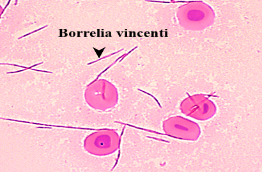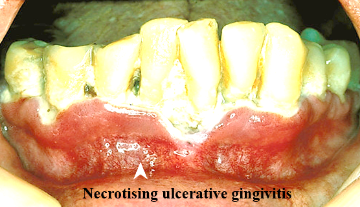

It is an acute ulcerative type of tonsillitis and gingivitis. Vincent first described this disease and its organism.
Necrotizing ulcerative gingivitis has been observed for centuries. Jean Hyacinthe Vincent, a French physician working at the Paris Pasteur Institute describes a fusospirochetal infection of the pharynx and palatine tonsils, causing “ulcero-membranous pharyngitis and tonsillitis”, which later became known as Vincent’s angina. Later in 1904, Vincent describes the same pathogenic organisms in “ulceronecrotic gingivitis”.
Disease spread by personal contact, kissing, using unclean towels etc.
1. Age: Usually seen in young middle age in the third to fourth decade.
2. Low immunity due to illness.
3. Dental: Local irritative lesions in the mouth, decayed teeth.
4. Vitamin C deficiency is an important factor.
5. Environmental: More common in temperate and tropical climates than arctic regions.
Gram negative fusiform bacillus with associated spirillum- Borrelia vincenti.

1. The infection usually involves one tonsil usually at its upper pole. It may spread to soft palate, gums, larynx and trachea.
2. The tonsil shows patches covered by a membrane.
3. The membrane is a pseudo membrane and is formed by necrosis of the superficial layers of the mucous membrane.
4. On removal of this pseudo membrane, an ulcerative area is exposed.
1. Throat pain.
2. High fever, malaise.
3. Foul breath.
4. Greyish membrane seen over tonsil.
5. Cervical lymphadenopathy.


1. Diagnosis is usually clinical.
2. Complete blood count.
3. Smear for fusospirochaetal bacteria and leukocytes.
1. Systemic: High antibiotics, Penicillin and its derivatives are very effective, Metronidazole can be given.
2. Local:
3. Isolation of the patient is useful to prevent spread of infection to surroundings.